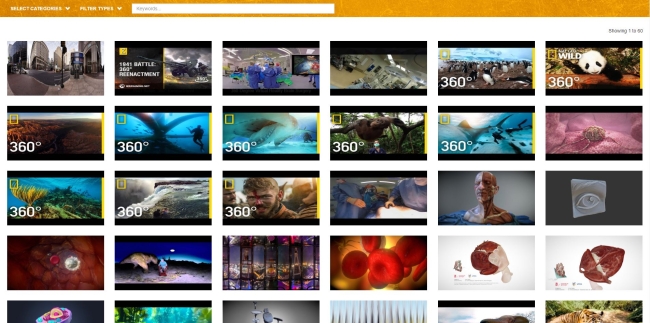You have /5 articles left.
Sign up for a free account or log in.

Susan Aldridge/Drexel University
Drexel University wants its instructors to take full advantage of virtual and augmented reality technology in their classrooms. The Philadelphia institution’s new repository of VR and AR content aims to make that easier than ever.
The online database, unveiled last month and set to be distributed this fall among Drexel instructors in the institution's Blackboard interface, includes more than 250,000 “artifacts” -- VR and AR images, 3-D objects, 360-degree panoramas -- that can be used across a wide range of disciplines. Instructors can use search terms like “heart diagram” or “skeleton” to find and download the images they want to use in their courses, both face-to-face and online.
The repository’s name looks strange on paper but rolls off the tongue: VRtifacts.
“This was an opportunity for us to share what’s possible with the faculty,” said Susan Aldridge, president of Drexel University Online. “It gives them a lot of ideas of how to utilize the content in their courses. It just makes their contents more robust.”
More from "Inside Digital Learning"
Criminal justice classes at George Washington University make use of an elaborate virtual crime scene.
One virtual reality expert sees a bright future for the technology in classrooms.
Journalism students at the University of Oklahoma grapple with VR as a media tool.
All of the VR content in the repository is open source, available for download by instructors. The institution can track the number of users and downloads through Blackboard.
Drexel has purchased 1,000 pairs of collapsible virtual reality glasses for less than $4 apiece; all of them will be distributed to accepted online students.
Faculty members will eventually be able to submit their own content, which will be reviewed by a site administrator according to a set of “minimum standards” currently being developed by Aldridge's team. There are also plans for a scoring system that faculty members can use to rate the quality of various images, and comments denoting which artifacts have been used for which courses.
Institutions have only begun to grapple with the possibilities and pitfalls of virtual reality. While some have invested in dedicated physical spaces for virtual reality innovation or incorporated the technology into classrooms, consensus on the value of the technology as a learning tool hasn't yet formed. With this repository, Drexel aims to offer instructors the flexibility to determine the role of virtual reality in their own pedagogy.
Drexel’s nursing, criminal justice and law programs already make use of virtual reality in some classrooms. Aldridge has had the repository idea for a couple years but only recently took steps to put it into action. She got connected a few months ago through higher ed colleagues to David Keesee, president of 3Dream, a technology company that works on 3-D animation. Keesee’s team had been developing a database of virtual reality content, and the prospect of partnering with a university offered a concrete road map for how the database could be utilized, Keesee said.
3Dream also started tagging each image with subject keywords, though instructional designers at Drexel have taken up that work as the project gets unveiled. “The beauty of all that is you take all the technical out of it, make it a very simple, easy-to-use searchable database,” Keesee said.
Launching the repository cost approximately $200,000, most of which went to 3Dream. Maintenance costs will be minimal, according to Aldridge.
The institution’s online learning team has begun training instructional designers on using the tool and teaching it to faculty members. Drexel’s six Online Learning Council Faculty Fellows, selected by the deans of the colleges to lead the university’s online efforts, have also gotten an early preview of the resource. Karyn Holt, chair of the fellows, thinks the repository will appeal to some faculty members more than others.
“My personal opinion is it is not going to be for every faculty member. It is not going to have a huge impact in terms of numbers,” Holt said. “But the faculty members that can use that asset, it will be huge in terms of that individual course.”
The most appealing feature, Holt said, is the ability to incorporate VR and other multimedia content into a class from the comfort of the Blackboard interface, rather than going to “eight sites,” scrolling through Google Images and wondering about copyright infringement.
Right now the repository integrates only with Blackboard, but Keesee’s company is working on plug-ins for D2L and Canvas as well. His goal is for other universities to use the existing repository as a base and then add content to it. Aldridge hopes other universities will follow Drexel's lead.
"We want something for the faculty to be able to easily explore as they find some things they perceive will be really helpful to them," Aldridge said.




